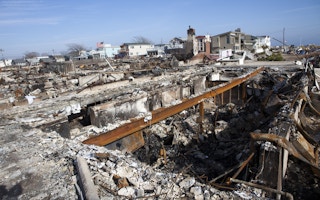Climate change could already be costing the US billions of dollars each year in hurricane damage alone.
Economists from Mexico and Europe believe that somewhere between $2bn and $14bn of the financial costs of hurricane damage in 2005 could be attributed to the impact of global warming.
This is a bold statement. But Francisco Estrada, an environmental economics researcher at the National Autonomous University of Mexico, and European colleagues report in Nature Geoscience that they have looked at the pattern of economic losses from hurricanes that matches a rise between 1990 and 2005 in the number and intensity of tropical cyclones.
They say that this upward trend in loss “cannot be explained by commonly-used socioeconomic variables”.
The distinction is an important one. Economic damage from climate-related events − ice storms, drought, flood, windstorms and heatwaves – has been on the increase for decades, but one explanation for this is population growth and economic development, even in the poorest regions.
Human headcount
The planet’s human headcount between 1990 and 2005 rose by around 80 million a year, so each year there were millions more potential victims, with more homes, farms and factories in the path of destruction.
But beyond that, the economists, who all have links to the Free University of Amsterdam in the Netherlands, see the fingerprint not of climate variability − the meteorological throw of the dice that sends a hurricane to a city centre rather than a deserted coast − but of underlying climate change.
They say in their study that the reason other economists have not seen this trend may be because of the methods and assumptions that lay behind the reasoning. The latest statistical approach has been different.
There is debate within climate science about whether North Atlantic hurricanes are on the increase, or whether the ones that make a landfall are simply more destructive.
Scientists at the US National Oceanic and Atmospheric Administration (NOAA) once worked out that the average hurricane released 200 times the energy overall of the entire electrical generating capacity of the world. Even the average hurricane would seem intense to someone in its path.
Another source of argument could be that hurricanes become likely as sea surface temperatures reach a threshold, and atmospheric temperatures are warming in response to increasing greenhouse gas proportions due to industrial and domestic combustion of fossil fuels.
Because of these factors, the latitudes at risk may be increasing, and hurricanes are striking cities and coasts not normally hitherto considered as being in danger of such hazards, and so they are less prepared for that emergency.
One such instance was Hurricane Sandy, which left a trail of havoc along the US coast and brought floods and destruction to New York in 2012.
Insurance companies in the US have been accused of not taking climate change seriously enough, but Dr Estrada and his colleagues began their study with insurance data.
Natural disasters
For decades, the European giant Munich Re has kept annual tallies of natural disasters and the costs of each in terms of lives, population displacement and economic damage.
Although better warning systems, more careful education and civic preparedness have helped reduce loss of life, the economic toll has risen, in terms of both insured and uninsured losses.
And the researchers are convinced that they have empirical evidence that climate change could have increased the costs of disasters in the past by between 2 per cent and 12 per cent.
“This finding can have major implications for the design of climate policy in the context of loss and damage from climate change at national and global scales,” they conclude.
“It suggests that a more cautious attitude is warranted when evaluating the current and future costs of climate change, as well as the expected benefits of mitigation and adaptation strategies.”

















